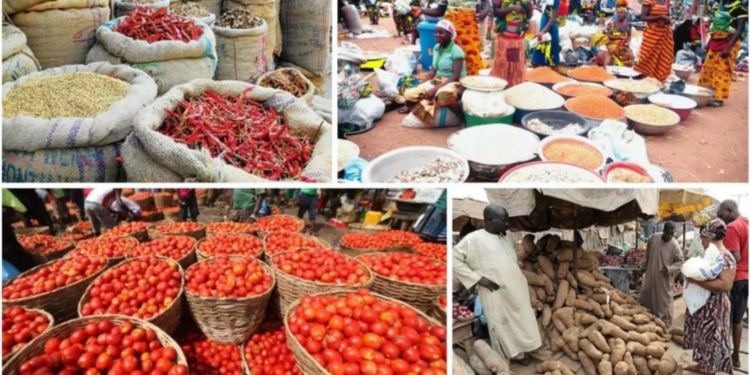Inflation, the often-discussed economic phenomenon globally, refers to the rate at which prices increase over a specific period. It reflects the overall rise in the cost of living or the price hike of specific goods and services.
Whether gauging the surge in the cost of groceries or the uptick in housing expenses, inflation signifies the degree to which purchasing power diminishes over time, typically measured annually.
Recommended reading: Nigeria’s inflation rate rises to 31.70% in February 2024
Measuring inflation rates
Government agencies employ various methodologies to gauge inflation, typically relying on consumer price indices (CPIs) to track changes in the cost of a predetermined basket of goods and services.
- The CPI basket mirrors items commonly purchased by households, with housing expenses often topping the list.
- By comparing the cost of this basket over time, expressed relative to a base year, analysts derive the consumer price inflation rate, a widely recognised metric for inflation tracking.
- Core consumer inflation, a subset of this analysis, zeros in on persistent inflation trends by excluding government-regulated prices and the more volatile costs of items like food and energy.
- Core inflation offers policymakers valuable insights into underlying economic dynamics, free from temporary supply disruptions or seasonal fluctuations.
- For a broader perspective on inflation, economists turn to indices like the GDP deflator, encompassing a more comprehensive array of economic activities beyond consumer spending.
High inflation drivers
High inflation often stems from loose monetary policies, where an excessive increase in the money supply outpaces economic growth, eroding currency value and driving up prices—a principle known as the quantity theory of money.
- Additionally, supply or demand shocks can fuel inflationary pressures.
- Supply disruptions, like natural disasters or spikes in production costs, can trigger “cost-push” inflation, while demand surges or expansionary fiscal and monetary policies may lead to “demand-pull” inflation by straining production capacity.
Nairametrics has compiled a list of the top 15 countries with the highest inflation rates in the world as at February 2024.
15. Myanmar
Inflation rate: 28.58%
Myanmar’s inflation rate surged to 28% in the second quarter of 2023, up from 27.5% in the previous quarter. Over the period from 1998 to 2023, the country’s inflation averaged 13.16%. Notably, it hit an all-time high of 54.02% in the fourth quarter of 2002 and reached a record low of -1.09% in the fourth quarter of 2011.
14. Cuba
Inflation rate: 31.34%
Cuba’s annual inflation rate declined to a 18-month low of 31.34% in December 2023, down from 31.78% in November and 34.13% in the preceding month. The country’s inflation rate averaged 28.14% from 2005 to 2023. Notably, it peaked at 77.3% in December 2021 and hit a record low of 0.8% in December 2008.
13. Nigeria
Inflation rate: 31.7%
In February 2024, Nigeria witnessed a surge in its annual inflation rate, reaching a new high not seen since 1996, at 31.7%. This marked an increase from 29.9% recorded in January and surpassed market expectations of 31%.
The spike was primarily attributed to the removal of oil subsidies and the devaluation of the Nigerian naira. Following the liberalisation of the foreign exchange market in June 2023, the naira depreciated by 69% by mid-February 2024. Consequently, import costs surged, profoundly impacting Nigeria’s import-dependent economy.
12. Malawi
Inflation rate: 33.5%
In February 2024, Malawi’s annual inflation rate stood at 33.5%, showing a decrease from the 35% reported in January 2024. Notably, food and non-food inflation rates were recorded at 42% and 22.1%, respectively.
11. Egypt
Inflation rate: 35.7%
In February 2024, Egypt’s annual urban inflation rate surged for the first time in five months, reaching 35.7%. This marked a notable increase from January’s 12-month low of 29.8% and exceeded forecasts of 25.1%.
It represented the highest inflation rate since October, driven by steep increases in food prices by 50.9%, transport by 17.6%, and housing by 10%. The rise followed the government’s decision to hike Cairo metro ticket prices by up to 20% in January, along with increases in internet services by 33% and electricity prices by 26%.
10. Iran
Inflation rate: 35.8%
In February 2024, Iran’s point-to-point inflation rate declined to 35.8% from 38.5% in the previous month. This decrease marked the lowest inflation rate since April 2022. Notably, food prices experienced the smallest increase since September 2020, rising by 31.6% compared to 38.9% in January.
9. Congo
Inflation rate: 46.8%
The inflation rate in Congo rose to 46.8% in December 2023, up from 45.8% in November of the same year. The average inflation rate in Congo from 1999 to 2023 stood at 23.22%. Congo experienced its highest inflation rate of 511.21% in December 2000 and its lowest of 1.35% in April 2013.
8. Sierra Leone
Inflation rate: 47.42%
In January 2024, the inflation rate in Sierra Leone dropped to 47.42% from 52.16% in December 2023. Over the period from 1986 to 2024, the average inflation rate in Sierra Leone was 28.14%. Sierra Leone’s highest inflation rate of 255.56% was recorded in April 1987, while its lowest was -21.76% in January 2000.
7. Zimbabwe
Inflation rate: 47.6%
In February 2024, Zimbabwe’s annual inflation rate surged for the fourth consecutive month, reaching 47.6%, the highest level in over a year, up from 34.8% in the previous month. This increase in inflation is primarily attributed to the ongoing depreciation of the Zimbabwean dollar against the US dollar.
6. Sudan
Inflation rate: 63.3%
Sudan’s inflation rate declined to 63.3% in February 2023 from 83.6% in January of the same year. The average inflation rate in Sudan from 1971 to 2023 stood at 69.5%, with the highest recorded at 422.78% in July 2021 and the lowest at -1% in December 1979.
5. Turkey
Inflation rate: 67.07%
In February 2024, Turkey’s annual inflation rate climbed to 67.07%, up from 64.86% in the preceding month, surpassing market expectations of 65.74%. This marked the highest level since November 2022, primarily fuelled by a significant increase in the minimum wage and government tax adjustments.
4. Venezuela
Inflation rate: 75.9%
In February 2024, Venezuela’s inflation rate declined to 75.9% from 107.4% in January of the same year. Venezuela’s inflation rate has averaged 3605.78% since 1973, with a record high of 344509.5% in February 2019 and a record low of 3.22% in February 1973.
3.Lebanon
Inflation rate: 123%
In February 2024, Lebanon experienced a decrease in its annual inflation rate, which fell to 123.2% from 177.3% in the previous month. This decline marked the lowest inflation rate since December 2022. The reduction was primarily attributed to softer increases in housing and transport prices, while food prices saw the smallest rise in nearly four years.
2. Syria
Inflation rate: 140%
Syria’s inflation rate dropped to 139.6% December 2023 from144.6% in November of the same year. Over the period from 1957 to 2023, the average inflation rate stood at 16.09%. The highest recorded inflation rate was 188.4% in March 2021, while the lowest was -31.05% in September 2014.
1. Argentina
Inflation rate: 276%
In February 2024, Argentina’s inflation rate rose to 276.2% from 254.2% in January of the same year. Over the period from 1944 to 2024, the average inflation rate stood at 189.97%. The highest recorded inflation rate was 20262.8% in March 1990, while the lowest was -7% in February 1954.
















